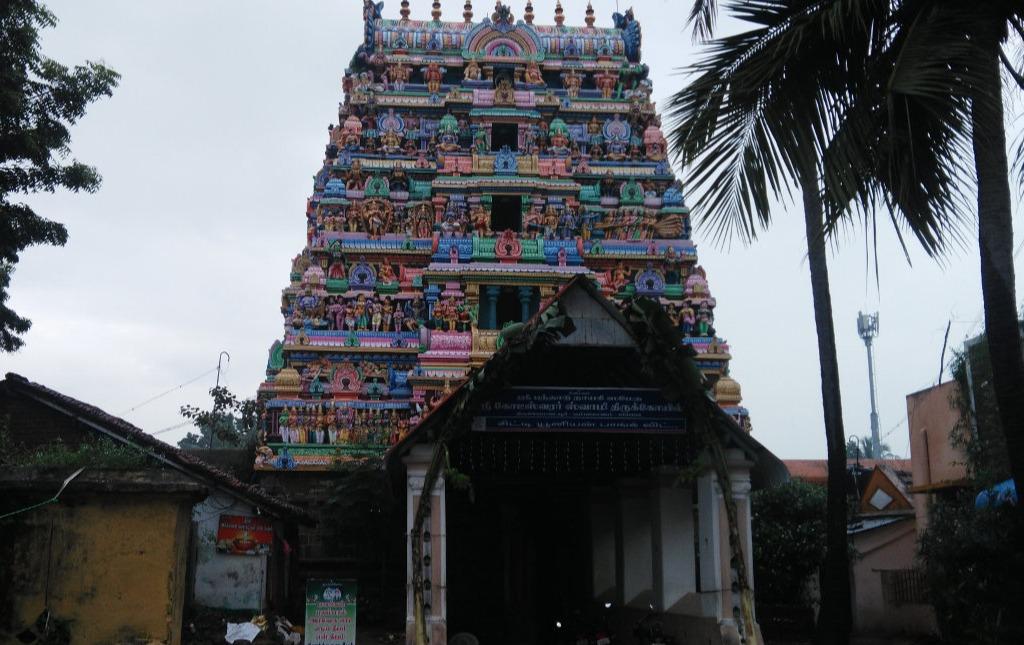Satyarathi, the ruler of the Tirihartha kingdom, had a son named Suruchi who was cursed and disfigured into a devilish form. His appearance was so frightening that people would flee upon seeing him. Desperate to restore his handsome visage, Suruchi sought Lord Shiva's grace. He was advised to bathe in the holy spring at Kottaiyur, which miraculously restored his beauty even beyond his original appearance. This ritual is particularly followed by women seeking to enhance their own beauty.
Sthala Puranam :
The Kottaiyur Temple is intricately linked to the origin of Kumbakonam and the Mahamaham festival. According to the Puranic story, Brahma assembled the seeds of all living organisms, as well as the Vedas and Puranas, into a pot known as the Amrita Kalasam (pot of nectar). This pot, referred to as "Kumbham" in Sanskrit and "Kudam" in Tamil, was adorned with flowers, vilvam leaves, auspicious cloth, sandal paste (chandanam), and a sacred thread, topped with a coconut. It was then secured with a string, similar to the kalasams used in rituals today, and placed on Mount Meru.
When the great flood, or Pralayam, occurred, it devastated all life on earth. The Kumbham, too, was displaced and floated on the floodwaters for many years before eventually settling at what is now Kumbakonam. Lord Shiva, in the guise of a hunter, broke open the pot with his bow and arrow, allowing life to begin anew. It is believed that some drops of the nectar from the pot fell at this temple site.
The Kottaiyur Temple is one of the seven temples that form the Kumbakonam Sapta Sthanam collective, which includes:
- Adi Kumbeswarar, Kumbakonam
- Amirthakadeswarar, Sakkottai
- Avudai Nathan / Atmanathar, Darasuram
- Kapardeeswarar, Tiruvalanchuzhi
- Koteeswarar, Kottaiyur
- Kailasanathar, Melacauvery
- Sundareswarar, Swamimalai
Sage Bhadrayoga worshipped Lord Shiva at many temples. Pleased with his devotion, Lord Shiva manifested as a Swayambhu Lingam amidst castor seeds that had fallen from the castor tree, which is referred to as “Heranda” in Sanskrit. The name Koteeswarar derives from “koti,” meaning one crore, and the name Kottaiyur comes from "kottai," meaning seed. The Shiva Lingam in this temple resembles castor seeds, reinforcing the name and significance.
In the Puranic story related to the Kapardeeswarar Temple at Thiruvalanchuzhi, King Haridhwajan was assisted by Sage Herandar. To save the world from a hole that appeared from Bhulokam to Patalam, Sage Herandar, who worshipped at Kottaiyur under the castor trees, entered the hole in the form of a bee. He restored the Cauvery River to the earth, a miracle believed to have occurred near Mela Cauvery.
A saying, “கொட்டையூரிற் செய்த பாவம் கட்டையோடே,” implies that sins committed in Kottaiyur persist until death, emphasising the temple's reputation for magnifying both good and bad deeds by one crore times. Consequently, devotees were once wary of entering Kottaiyur. Goddess Parvati, known as Pandhaadu Nayaki here, is believed to kick away the sins of devotees like a ball, alleviating their problems.
Satyarthi, the king of the Trihartha kingdom, had a son named Suruchi who was cursed to appear as a disfigured rakshasa. To cure him, he was advised to visit this temple near Kumbakonam and bathe in the river there. After worshipping Lord Shiva at this temple, Suruchi regained his original form. This story contributes to the belief that bathing in the Kaveri River and worshipping Shiva at this temple enhances one's appearance.
Historically, the temple is referred to as Koteeswaran (or Koteechuram), Vilvaranyam (for its Vilvam trees), and Herandapuram (after Sage Herandar). The core temple architecture is Chola, with additions by the Pallavas. Inscriptions mention Chola kings Rajadhiraja I and Kulothunga Chola III.
The main Shiva Lingam in the temple has droplets of water emerging from its top, symbolising the Ganges flowing from Lord Shiva’s hair. Parvati is depicted in a playful posture, matching her name here. Vinayakar, known as Koti-Vinayakar, is a self-manifested murti with many smaller images. Murugan, or Koti-Subramanyar, has a separate shrine with his consorts. The Navagraham shrine features all planetary deities with their vehicles. The temple also displays various engravings, including one of Manu Needhi Cholan who upheld justice by punishing his son for a crime.
Arunagirinathar has praised Murugan of this temple in his Thiruppugazh hymns.
